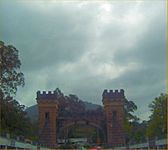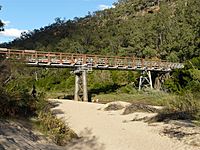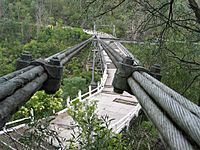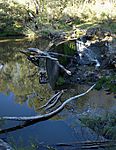Ernest de Burgh facts for kids
Quick facts for kids
E M de Burgh
|
|
|---|---|
 |
|
| Born | 18 January 1863 |
| Died | 3 April 1929 (aged 66) |
| Known for | Roads engineer |
| Spouse(s) | Constance M Yeo (1888-1929) |
| Children | Thomas de Burgh |
Ernest Macartney de Burgh (born January 18, 1863 – died April 3, 1929) was an amazing engineer from Ireland. He moved to Australia and became a very important civil engineer in New South Wales. He was the chief engineer for water supply and sewerage, meaning he helped make sure people had clean water and good drainage systems.
Contents
Early Life and Education
Ernest de Burgh was born in Sandymount, County Dublin, Ireland, on January 18, 1863. He was the youngest son of Rev. William de Burgh. Ernest went to Rathmines school and the Royal College of Science for Ireland. Before moving to Australia, he worked on building railways in Ireland.
Engineering Career in Australia
Ernest de Burgh moved to Australia and arrived in Melbourne on March 21, 1885. Soon after, he traveled to Sydney and quickly got a job with the New South Wales public works department.
Building Bridges Across Rivers
In 1887, Ernest was put in charge of building steel bridges in the countryside. He later became the main engineer for bridges. He designed many important bridges over major rivers like the Murray, Murrumbidgee, Lachlan, and Hunter. One famous bridge he designed was the Hampden Bridge over the Kangaroo River.
Designing Dams and Water Systems
In 1903, Ernest started working with water supply and sewerage. He traveled to Europe to learn more about building dams and water systems. After returning, he did important work on the Burrinjuck Dam and the Murrumbidgee irrigation scheme.
By 1909, he became the chief engineer for harbors and water supply. In 1913, he became the chief engineer just for water supply and sewerage. He designed and watched over the building of huge reservoirs for Sydney's water supply. These included the Cataract, Cordeaux, Avon, and Nepean dams. He also worked on the Chichester scheme for the Newcastle area and the Umberumberka scheme near Broken Hill.
While he was chief engineer for harbors, he also designed a very advanced coal jetty and ship-loader at Port Kembla.
Later Life and Lasting Legacy
Ernest de Burgh was a member of the Institution of Civil Engineers in London. He even won the Telford premium award twice for his excellent work.
Two important places are named after him:
- The De Burghs Bridge over the Lane Cove River in Sydney.
- The De Burgh Dam near the Burrinjuck Dam. This dam is special because it was Australia's first reinforced-concrete thin arch dam.
Ernest married Constance Mary Yeo on March 20, 1888. They had two sons and a daughter. One of his sons, Thomas de Burgh, also became an engineer.
Ernest de Burgh retired on November 22, 1927. He passed away on April 3, 1929, in Vaucluse, Sydney.
De Burgh Timber Truss Bridges
Ernest De Burgh's bridges used a special type of timber truss, which is a strong framework. His design was the fourth of five types used in Australia. Each new design, including his 1899 de Burgh truss, was an improvement on the ones before it.
Images for kids
-
Hampden Bridge Kangaroo Valley -
Bridge across the Macdonald River -
De Burgh Dam near the Burrinjuck Dam.





